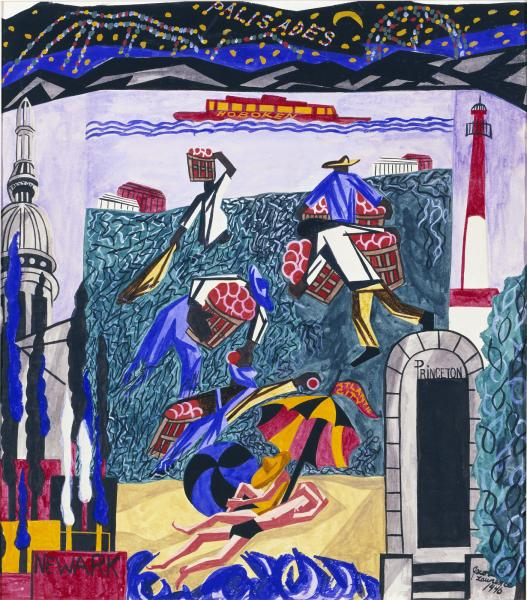
Title
New Jersey, from the United States Series
Date
1946
Location
Smithsonian American Art Museum
Dimensions
(61.2 x 50.9) cm
Medium
Tempera Paint on Fiberboard
Jacob Armstead Lawrence was a renowned painter in America who did his paintings on subjects that involve African-American historical background and contemporary life using a style he termed dynamic cubism. His style majored in narratives such as migration and war collection series, and he did not incorporate many French colors, art, and shapes. His career was characterized by illustrations of African Americans’ experiences, which was evident through the color backgrounds that were mainly black and brown. His work was majorly and widely acclaimed as an African American Art, and received acceptance and recognition across the country (Truettner). He became the most famous African American artist, and since then, he continued to earn accomplishments including being a 15 years’ professor at the University of Washington (Hills 321). His works were majorly in series, which he created through several individual panels, for narrating his stories that had experimental and compelling reality (McDermon). I have chosen to discuss Jacob Lawrence’s work “New Jersey from the United States” due to its classic nature and appealing artistic style compounded by a symbolic choice of colors.
I was enchanted by his artwork “New Jersey, from the United States series,” which bears an explanation of how the spirit of migration is deeply inscribed in the African Americans’ DNA. According to the DICP model, this painting has bright reds, browns, black, white, yellow-orange, and blue, creating specific naturalistic color blocks and humans, mostly African Americans. There is also a depiction of recreation as seen by the umbrellas and the ball, not forgetting that New Jersey is the birthplace of baseball, according to Matlin (454). The painting depicts the transition from slavery to a hardworking community in a farm plantation setting served by an excellent shipping system. This classical representation showcases the African Americans’ spirit to support and raise educated families as depicted by the inclusion of Princeton University.
His work could be described as an image and word combined with poetry with a repetition of specific shapes, which reminds viewers of slave labor and Black American journey to gaining freedom. According to Jacob Lawrence, the journey to freedom was pioneered by the acquisition of civil rights, education, and social status. His painting also indicates an oppressive past that would later lead to a safer present, full of hope and promise a better life, even in the most unexpected circumstances. This is a change depicted by the Hudson River. The golden-colored umbrellas are an implication of hope for a change soon. Hoboken, a city in New Jersey, as it is in the background, is an expert inclusion of the changing times because it is the place where the Harlem Renaissance movement operated (Matlin, 451). The setting is also a representation of migration since New Jersey witnessed Germans’ highest immigration rate than any other place in the United States after WWII.
Jacob Lawrence’s work had a combination of Social Realism, abstraction in modernity, and the history African Americans encountered in his times. Despite the restraints, he focused on his communication on humanity’s struggles and the resonated aspirations from viewers across diversity (Gulla et al. 127). The Harlem Renaissance warning was among his much artistic maturity, together with the Abstract Expressionism of waxing. Jacob’s path was considered unique as he told poignant stories of mental illness, migration, and war, which resulted in a mighty influence, especially on the younger generation of artists (PBS). Despite being a member of many movements, Jacob Lawrence was a major influence on the Harlem Renaissance that led to the blossoming of literary, visual, and musical arts within the African American community in Harlem, New York (Hills, 318). He lived in a time characterized by a high number of African Americans leaving the rural areas for urban centers in search of better jobs and livelihoods (Patricia 237). By then, the political system was segregated, making Jacob Lawrence a frequent reader of news articles to keep updated on current happenings.
Conclusively, my first impression of Jacob Lawrence’s art was that he had a great taste for colors, shapes, and drawings explaining real experiences. As I learned about his work, I came across many pieces of information that reshaped my understanding of his art. As a crucial player in the Harlem Renaissance, Jacob Lawrence’s work is inspirational, content-centered, and an inscription of the African American community’s journey and experiences. Understanding the artist’s historical background made it easy for me to read and interpret his drawings easier, thus achieving a better understanding of his art. These insights enabled me to deduce meanings since most of his works express stories about empowering the African American community, fighting for social equality and education. All this created a good last impression of Jacob Lawrence as an artist who had his community’s interests at heart. Lastly, the more I read about him and examined his work, the more I could see the dark past of the African American community. This gave me a chance to celebrate the little achievements he made in his iconic art career, and as a professor of art.
References
Public Broadcasting Service. “Revisiting the Great Migration through paintings and poetry.” Public Broadcasting Service, 2015. Web.
Gulla, Amanda Nicole, and Molly Hamilton Sherman. “Art as Exploration: Jacob Lawrence and the Great Migration.” Inquiry-Based Learning Through the Creative Arts for Teachers and Teacher Educators. Palgrave Macmillan, Cham, 2020. Web.
Hills, Patricia. Painting Harlem Modern: The Art of Jacob Lawrence. University of California Press, 2019.
Matlin, Daniel. “Encompassing Life, Encompassing Art: Romare Bearden.” Reviews in American History, vol. 48, no. 3, 2020, pp. 449-456. Encompassing Life, Encompassing Art: Romare Bearden. Web.
McDermon, Daniel. “A Century of Jacob Lawrence.” The New York Times. n.d. Web.
Truettner, William. “Jacob Lawrence.” Smithsonian American Art Museum. n.d. Web.